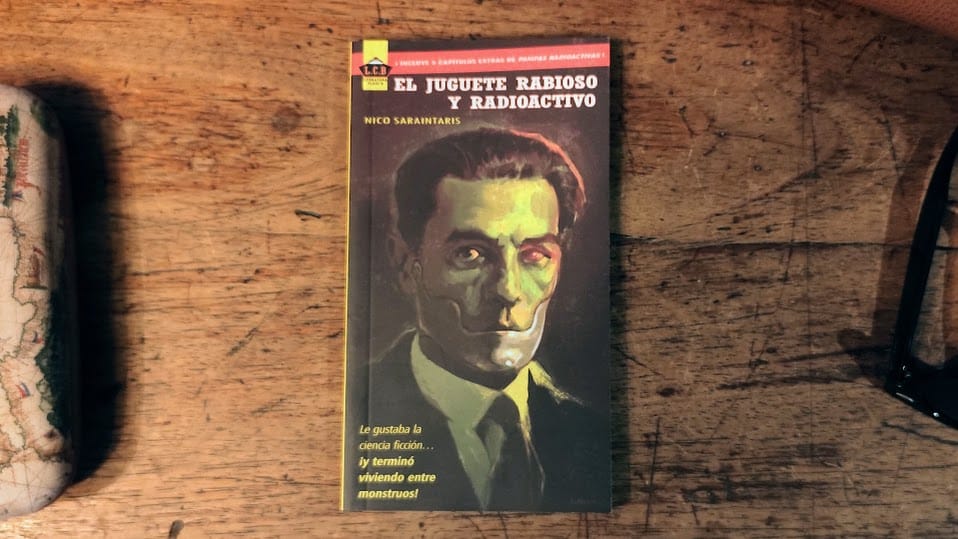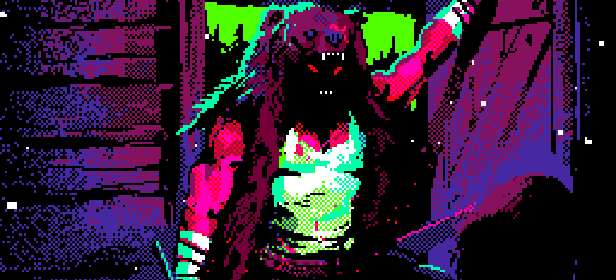LCB Game Studio is an Argentine independent studio formed by Nicolás Saraintaris and Fernando Martínez Ruppel . The duo works as follows: Saraintaris is in charge of the texts, game design, and programming; Ruppel, on the other hand, works on the music, illustrations, and sound effects. The project's name is an acronym for Literatura Clase B , which is simply the name the duo created to publish their genre fiction stories in print. Such is the case with Saraintaris's El juguete rabioso y radioactivo (The Rabid Radioactive Toy ), which some readers may remember as a lost gem from their early Twitter years.

The publishing house's initial concept evolved into its current form as a video game studio, where these youthful obsessions weren't abandoned but, quite the contrary, deepened, perfected, and channeled into economically viable projects. This gave rise to the concept of "Pixel Pulps": fast-paced visual novels inspired by the aesthetics of 20th-century pulp literature and the graphics of 1980s personal computers, such as the ZX Spectrum.
For those of us who grew up in that era, it's as if the Monkey Island illustrations became a game in themselves. The studio has been releasing these pixel pulps at a very consistent pace since its first release in 2022:
Mothmen 1966 (2022)
Set during the 1966 meteor shower, it features a strange fictional narrative featuring various cryptids, the most notable of which are the mothmen. Juanma shared more about this game here.

Varney Lake (2023)
Set in the summer of 1954, it follows three friends who encounter an injured vampire, exploring themes of friendship and mystery. It's in the same adventurous vein as Stand By Me and The Goonies .
Bahnsen Knights (2023)
Set in 1986 in Tornado Alley, USA, the protagonist infiltrates a religious sect obsessed with American sports cars from the 1980s.

Grizzly Man (2024)
Set in Alaska during the salmon run in 1983, the characters confront a serial killer who wears a grizzly bear skin.
Do Pixel Pulps work?
The games are basically a kind of digital Choose Your Own Adventure . That is, they are primarily narrative video games, structured like novels, where at key points in the story, players have to choose between alternatives. This includes actions, dialogue, and a small combat system. There's also a solitaire minigame, all controlled through text commands.
While this system can sometimes feel a bit clumsy (especially in combat situations or minigames), the result is more than satisfactory. Each game manages to create a very unique atmosphere, producing a highly effective immersion effect supported by the narrative and illustrations. This is the most notable artistic aspect of pixel pulps. If this didn't work, the entire project would be unsustainable. But it works very well, and that explains the total sales of 70,000 copies, according to Saraitanis himself.
Each Pixel Pulp explores a very B-movie or pulp fiction premise, such as the 1966 Mothman invasion, a religious cult obsessed with sports cars, or an Alaskan serial killer disguised in a bearskin. The musical work is key, as are Ruppel's illustrations, which create the atmospheric effect that sustains these interactive visual novels.
The experience is enhanced if you play in a climate that suits the game: a lonely night, a rainy afternoon, or a foggy dawn. These are games to be enjoyed in peace. For now, I've finished Mothmen 1966 , and I think the next game will be Bahnsen Knights .
Where to play Pixel Pulps
All of LCB 's games are available on multiple platforms: Steam , Nintendo Switch , and PlayStation . For the creators, being on these platforms meant additional effort and the decision to make all their games in Unity. A process that can be cumbersome and exhausting for a studio of just two people. Despite that, having a publisher like Chorus Worldwide allowed them to streamline these processes and have a presence at various global events that served as a means of publicity for the game. Something that would have been very complicated (almost impossible) if they had gone the self-publishing route.

As we mentioned above, those looking for a quiet game with a strong narrative bent and leaning toward the atmospheric will find the Pixel Pulps an ideal place. Those looking to explore the narrative and aesthetic boundaries of pixel art and text adventures will find the same. Those looking for good pulp or genre stories should definitely check out these games.
I'm not really aware of any other similar games or games with common characteristics. I understand there are several with all the elements scattered throughout (pixel art, text games, and genre tropes), but the interesting thing about LCB 's tetralogy is that it's an Argentine-based studio, and they were able to combine all those elements to create something we could call a "work."

You simply need to look at the plates that illustrate this article and are included in each set. Masterpieces of illustration in a technical style that was replaced by "obsolete." It's as if someone from the Renaissance, at the height of perspective painting, chose to revisit Byzantine art. It's more than simple nostalgia, more than just a "retro" aesthetic. It's a quest to maximize the aesthetic and narrative possibilities of an "exhausted" format.
Ultimately, it's a demonstration of how to emerge strong from rather daunting limitations, and how to turn that into a commercial ( and artistic ) success. I hope the Saraintaris-Ruppel duo still has many miles ahead of them.



